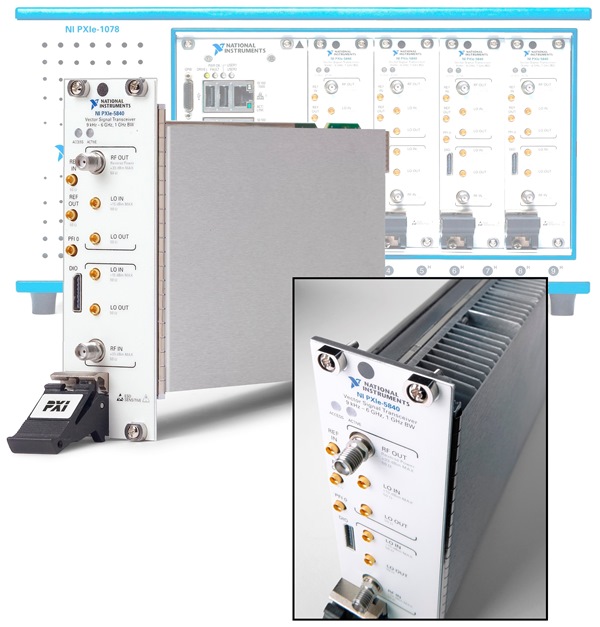By Richard Comerford, Senior Technical Editor

Designed by National Instruments (NI) to solve the most challenging RF design and test applications, the NI PXIe-5840 vector signal transceiver (VST) module comes at a critical time. The number of IoT devices is growing at a phenomenal rate, from 2 billion objects in 2006 to a projected 200 billion by 2020, according to data gathered by IDC, Intel, and the United Nations. If that growth occurs, there would be about 26 smart objects for every human being! Therefore, engineers will need very sophisticated, yet economical, tools to meet the demand and to make those devices communicate reliably.
The NI PXIe-5840 module is NI’s second-generation VST; its first-generation part was an Electronic Products Product of the Year and was NI’s best-selling PXI instrument ever. The 5840 is a considerable advance over its first unit; for one thing, the new VST is the first with a 1-GHz measurement bandwidth, five times wider than the previous version. That 1-GHz bandwidth suits the 5840 for 5G, RFIC, radar-prototype, and mobile/Internet of Things device testing, among other applications. Coupled with the wider bandwidth is high measurement accuracy, to −50 dB, enabling the testing of an 802.11ax key parameter: Error Vector Magnitude (EVM).

Furthermore, the NI PXIe-5840 — which combines a 6.5-GHz RF vector signal generator, a 6.5-GHz vector signal analyzer, a high-performance user-programmable FPGA, and high-speed serial and parallel digital interfaces — occupies only two slots in a PXI Express chassis, or one-third less space than the previous model.
Although there are pairs of non-modular, monolithic instruments that can make similar measurements very precisely, they are much too expensive for multichannel measurements in commercial testing (such instruments are in the $250,000-per-channel-and-up range, while the 5840 is priced under $70,000, although a chassis and controller are needed). The closest competitors to the 5840 are the Keysight M9420A VXT and the Cobham AXIe VST. In the case of the M9420A, there are two major differences: the module takes up five slots, and users can’t directly customize the FPGA software to make the instrument do what they want (although Keysight itself will provide custom FPGA programming). The Cobham system is aimed at military avionics and software-defined radio and doesn’t support the flexibility needed for other telecom scenarios.
As with the first generation, the new VST lets engineers actually get inside the instruments by inputting custom code created with LabVIEW to the FPGA, thereby tailoring the instrument to their specific application. “Although engineers can use the second-generation VST to solve many advanced RF test applications right out of the box,” said Charles Schroeder, NI vice president of RF product marketing, “Using the intuitive LabVIEW system design software, engineers can transform the VST into exactly what they need it to be at the firmware level, and ultimately address the most demanding test and measurement challenges.”
Use of a larger FPGA speeds up measurement by a factor of 10 compared to traditional instrumentation, allowing measurement computations to be performed simultaneously rather than consecutively in piecemeal fashion. To keep the FPGA cool, the module uses extensive heat sinking, which takes up about one slot-width, as the accompanying image shows.
The image also underscores another benefit of the 5840’s size: Users can configure a chassis with multiple modules for simultaneous multichannel testing. While the image shows four modules in a nine-slot chassis, users can tackle 8×8 MIMO testing using eight 5840 modules in a single 18-slot chassis.
Each month, the editors at Electronic Products nominate the most compelling new products and vote to determine a single Product of the Month . During the nomination process, the editors look beyond the technical specifications of a product to evaluate technological advancements, the potential impact on target industries and applications, and the importance to electronic engineers.
Advertisement
Learn more about National Instruments





